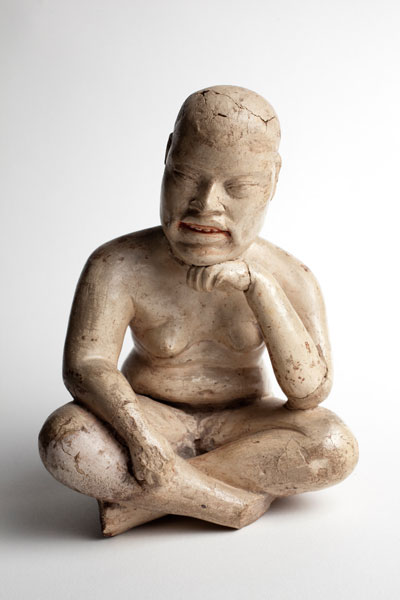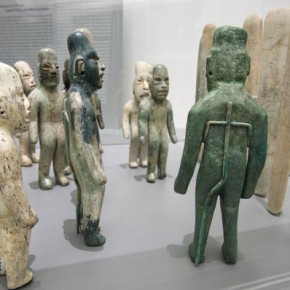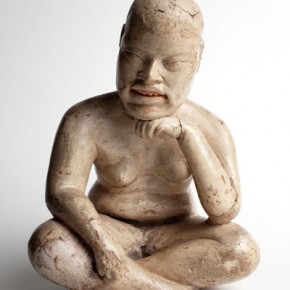
Seated figure with head resting on hand, Mexico, Puebla, Las Bocas. 1200-800 BC White-slipped ceramic. Museo Amparo, Puebla. Photo: Consejo Nacional para La Cultura y Las Artes- INAH- Mexico- Javier Hinojosa.
Dec 1, 2010–Jan 9, 2011, Olmec: Colossal Masterworks of Ancient Mexico, The Los Angeles County Museum of Art, 5905 Wilshire Blvd, Los Angeles, CA.
This is the first West Coast presentation of massive works and small-scale sculptures produced by Mexico’s earliest civilization, which began around 1400 BC and was centered in the Gulf Coast states of Veracruz and Tabasco. Olmec architects and artists produced the earliest monumental structures and sculptures on the North American continent, including enormous basalt portrait heads of their rulers, which can weigh up to twenty-four tons. Small-scale jadeite objects, which embody the symbolism of sacred and secular authority among the Olmec, attest to the long-distance exchange of rare resources that existed as early as 1000 BC, and Olmec artists were unsurpassed in their ability to work this extremely hard stone with elementary tools of chert, water, and sand. The opening of Olmec will coincide with Los Angeles celebrations of the bicentennial of Mexico’s independence and the centennial of the Mexican revolution. The exhibition is co-organized by Mexico’s Instituto Nacional de Antropología e Historia (National Institute of Anthropology and History), LACMA, and the Fine Arts Museums of San Francisco, and is curated at LACMA by Virginia Fields, senior curator of Arts of the Ancient Americas. For more info: LACMA
- Colosal Head 5, Mexico, Veracruz, San Lorenzo Tenochtitlan, Municipality of Texistepec, 1200-900 BC, Basalt. Museo de Antropología de Xalapa, Universidad Veracruzana, Photo: Consejo Nacional para La Cultura y Las Artes- INAH- Mexico- Javier Hinojosa.
- Colossal Masterworks of Ancient Mexico, The Lynda and Stewart Resnick Exhibition Pavillion, Los Angeles County Museum of Art Conaculta-INAH, Photo: 2010 Museum Associates/LACMA.
- Seated figure with head resting on hand, Mexico, Puebla, Las Bocas. 1200-800 BC White-slipped ceramic. Museo Amparo, Puebla. Photo: Consejo Nacional para La Cultura y Las Artes- INAH- Mexico- Javier Hinojosa.






